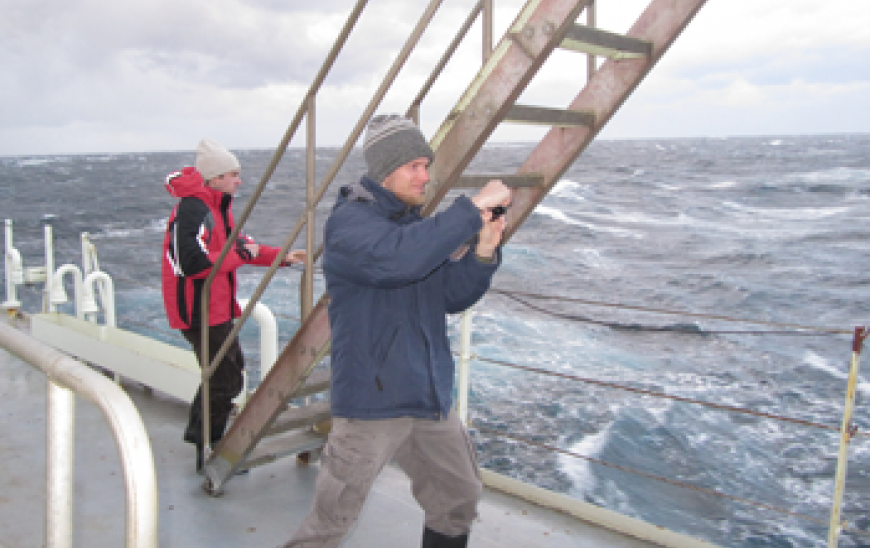The Stanford School of Earth, Energy & Environmental Sciences is now part of the Stanford Doerr School of Sustainability.
This page is currently being maintained for archival purposes only. For the latest information, please visit us here.
Internal waves break in undersea surf zones
By
Louis K. Bergeron
April 5, 2013
Eric D'Asaro

Graduate student Dan Whitt and Assistant Professor Leif Thomas on board the R/V Knorr transiting the Gulf Stream last year
Stanford researchers Leif Thomas and Dan Whitt have discovered an undersea surf zone, where wind-spawned waves traveling as much as 500 meters below the sea surface break as they hit the boundaries between currents of differing density, such as cool subpolar and warm subtropical currents, causing the water carried by the currents to mix.
Their finding has ramifications for understanding how heat, salinity, and nutrients are transferred between currents and by extension, globally. The new data should also aid in improving the physics behind computer models used to predict climate.
The ocean is multi-layered, with denser waters down deep and lighter waters near the surface. Cooler temperature and higher salinity both increase the density of water The density of a layer depends primarily on temperature and salinity. Internal waves – some extending laterally as much as several hundred kilometers – travel along the horizontal boundaries between layers of differing densities in an analogous way to how surface waves move on the air-sea boundary.
Thomas, Assistant Professor in the Department of Environmental Earth System Science (EESS), and doctoral candidate Whitt, developed a mathematical model analyzing how internal waves propagate in the ocean and interact with currents. Whitt is lead author of a paper describing their research that was published online by the American Meteorological Society’s Journal of Physical Oceanography.
Their model showed that when internal waves hit a current with a different density, they slow down and break, just as surface waves break when their progress is slowed by shallows, and mixing results.
“Strong ocean currents such as the Gulf Stream present ideal conditions for internal wave breaking,” Thomas said. “We basically discovered a surf zone for these wind-driven internal waves.”
Last year on a research voyage funded by the Office of Naval Research, Thomas and Whitt observed preferential breaking of internal waves and enhanced turbulence along the Gulf Stream, where subpolar currents and subtropical currents meet, just as their theory predicted. They amassed ample data on internal waves and also on small scale, lateral, near-surface mixing in the upper 100 meters of the Gulf Stream. The next step in their research will be delving deeper into analyzing both forms of mixing and their impact on the large-scale ocean circulation and, by extension, climate. They are conducting their mathematical analyses of the data at the Center for Computational Earth and Environmental Science (CEES) in the School of Earth Sciences.



